.
Wisps of the Veil Nebula. Wisps like this are all that remain visible of a Milky Way star.
About 9,000 years ago that star exploded in a supernova leaving the Veil Nebula,
also known as the Cygnus Loop.
At the time, the expanding cloud was likely as bright as a crescent
Moon, remaining
visible for weeks to people living at the dawn of recorded history.
Today, the resulting supernova remnant
has faded and is now visible only through a small telescope directed
toward the constellation of the Swan (Cygnus).
The remaining Veil Nebula is physically huge, however, and even though it lies about 1,400
light-years distant, it covers over five times the size of the full
Moon.
In images like this of the complete Veil Nebula, studious readers
should be able to identify several of the individual filaments.
A bright wisp at the right is known as the Witch's Broom Nebula: image and copyright by Joaquin Ferreiros (NASA), 26 November 2012
What
I'm doing
is creating
interesting
patterns
in the
discharge
of a
supernova
until
someday when
another
aspect of
the
supernova
will
stomp me
in the
face
and put
me in
a
casket.
is creating
interesting
patterns
in the
discharge
of a
supernova
until
someday when
another
aspect of
the
supernova
will
stomp me
in the
face
and put
me in
a
casket.

Smoke-like Wisps in the Veil Nebula, taken by the Hubble Space Telescope WFPC2 instrument, November 1997, with an exposure time of 7400 seconds: image by William P. Blair and Ravi Sankrit (Johns Hopkins University), NASA, ESA, 10 October 2000 (Hubble European Information Centre)
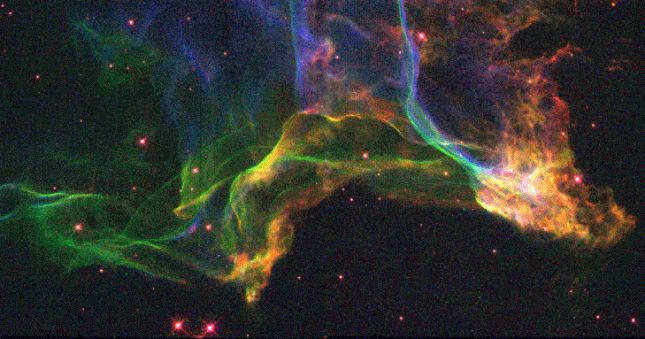
The Cygnus Loop. The shockwave from a 20,000-year-old supernova explosion in the constellation of Cygnus is still expanding into interstellar space. The collision of this fast moving wall of gas with a stationary cloud has heated it causing it to glow in a spectacular array of visible colours as well as high energy radiation, producing the nebula known as the Cygnus Loop (NGC 6960/95). The nebula is located a mere 1,400 light-years away. The colors used here indicate emission from different kinds of atoms excited by the shock: oxygen-blue, sulfur-red, and hydrogen-green. This picture was taken with the Wide Field and Planetary Camera 2 on board the Hubble Space telescope: image by J. Hester (ASU), NASA, 23 June 2001 (NASA)
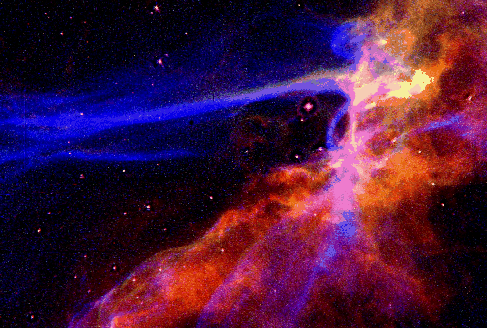
Rampaging Fronts of the Veil Nebula. A supernova explosion of a high-mass star results in fast moving blast waves. At the front of the waves shown above, ionized gas in the Veil Supernova Remnant rushes out from the explosion, sweeps up material, and breaks up many atoms into constituent ions and electrons. Observations with the Hubble Space Telescope in 1993 indicate that the blue shock wave was catapulted away from the stellar explosion after the red shock wave and has yet to catch up to it in some regions. The Veil Supernova Remnant has a very large angular size -- six times the diameter of the full moon -- and different parts of it are known as the "Cygnus Loop" and catalog numbers NGC 6960, NGC 6979, NGC 6992, and NGC 6995: image by J. J. Hester (Arizona State University), WFPC, HST, NASA, 7 March 1996 (NASA)
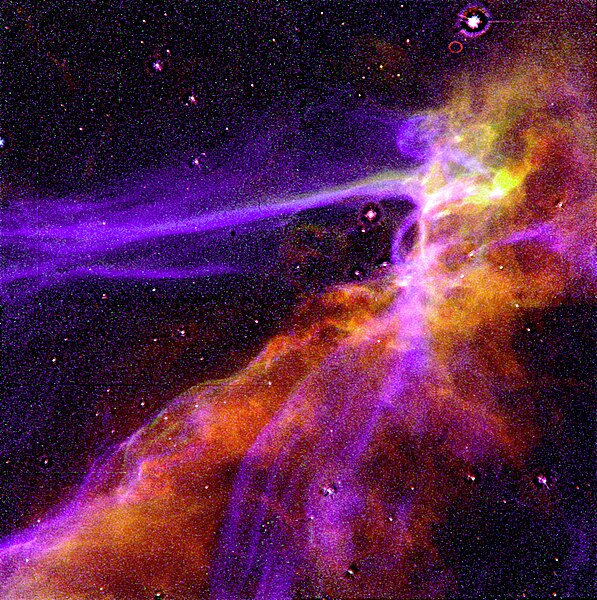
Cygnus Loop Supernova Blast Wave. This is an image of a small portion of the Cygnus Loop supernova remnant, which marks the edge of a bubble-like, expanding blast wave from a colossal stellar explosion, occurring about 15,000 years ago. The Hubble Space Telescope image shows the structure behind the shock waves, allowing astronomers for the first time to directly compare the actual structure of the shock with theoretical model calculations. Besides supernova remnants, these shock models are important in understanding a wide range of astrophysical phenomena, from winds in newly-formed stars to cataclysmic stellar outbursts. The supernova blast is slamming into tenuous clouds of interstellar gas. This collision heats and compresses the gas, causing it to glow. The shock thus acts as a searchlight revealing the structure of the interstellar medium. The detailed HST image shows the blast wave overrunning dense clumps of gas, which despite HST's high resolution, cannot be resolved. This means that the clumps of gas must be small enough to fit inside our solar system, making them relatively small structures by interstellar standards. A bluish ribbon of light stretching left to right across the picture might be a knot of gas ejected by the supernova; this interstellar "bullet" traveling over three million miles per hour (5 million kilometres) is just catching up with the shock front, which has slowed down by plowing into interstellar material. The Cygnus Loop appears as a faint ring of glowing gases about three degrees across (six times the diameter of the full Moon), located in the northern constellation, Cygnus the Swan. The supernova remnant is within the plane of our Milky Way galaxy and is 2,600 light-years away. The photo is a combination of separate images taken in three colors: oxygen atoms (blue) emit light at temperatures of 30,000 to 60,000 degrees Celsius (50,000 to 100,000 degrees Fahrenheit); hydrogen atoms (green) arise throughout the region of shocked gas; sulfur atoms (red) form when the gas cools to around 10,000 degrees Celsius (18,000 degrees Fahrenheit): image by J. J. Hester (Arizona State University), NASA, 1 January 1993 (NASA)
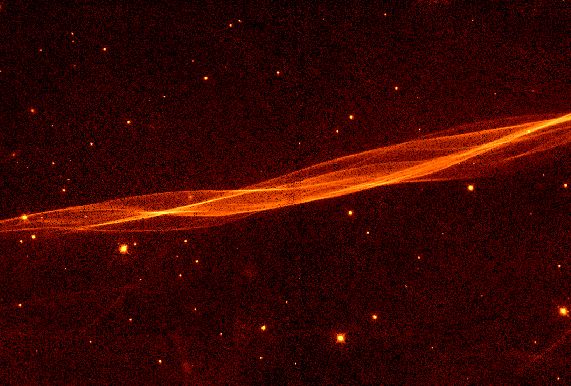
Filaments In The Cygnus Loop. Subtle and delicate in appearance, these are filaments of shocked interstellar gas -- part of the expanding blast wave from a violent stellar explosion. Recorded in November 1997 with the Wide Field and Planetary 2 Camera on board the Hubble Space Telescope, the picture is a closeup of a supernova remnant known as the Cygnus Loop. The nearly edge-on view shows a small portion of the immense shock front moving toward the top of the frame at about 170 kilometers per second while glowing in light emitted by atoms of excited Hydrogen gas. Not just another pretty picture, this particular image has provided some dramatic scientific results. In 1999, researchers used it to substantially revise downward widely accepted estimates of distance and age for this classic supernova remnant. Now determined to lie only 1,440 light-years away, the Cygnus Loop is thought to have been expanding for 5-10 thousand years: image by William P. Blair and Ravi Sankrit (Johns Hopkins University), NASA, 26 April 2000
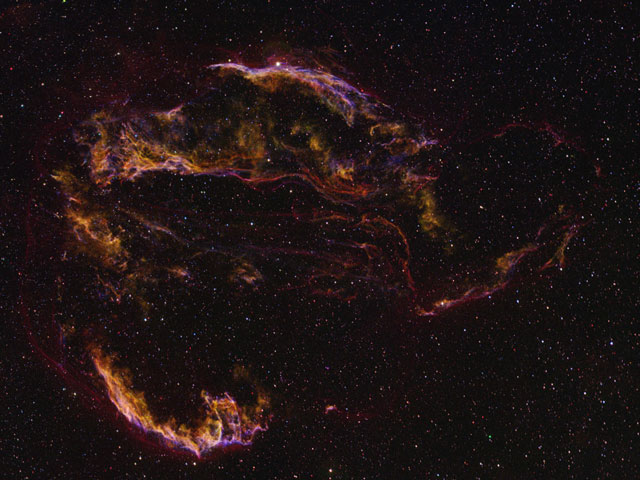
The Veil Unveiled. These wisps of gas are all that remain visible of a Milky Way star.
Many thousands of years ago that star exploded in a supernova leaving the Veil Nebula, pictured above.
At the time, the expanding cloud
was likely as bright as a crescent Moon toward the constellation Cygnus,
visible for weeks to people living at the dawn of recorded history.
The supernova remnant lies about 1400 light-years away and covers over five times the size of the full Moon.
The above image of the Veil was made clearer by digitally dimming stars in the frame.
The bright wisp at the top is known as the Witch's Broom Nebula
and can be seen with a small telescope.
The Veil Nebula is also known as the Cygnus Loop: image and copyright by Mikael Svalgaard, 6 December 2005 (NASA)
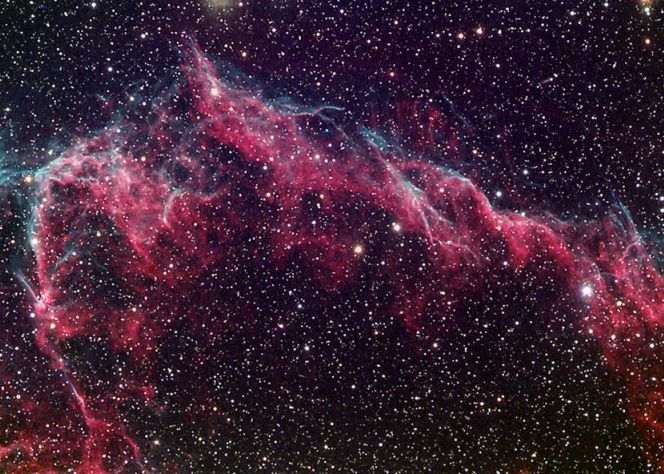
NGC 6992: A Glimpse of the Veil. After 5,000 years, the gorgeous Veil Nebula is still turning heads. Catalogued as NGC 6992, these glowing filaments of interstellar shocked gas are part of a larger spherical supernova remnant known as the Cygnus Loop or the Veil Nebula -- expanding debris from a star which exploded over 5,000 years ago. This color digital image of a bit of the Veil has been processed and enhanced to reveal stunning details in the diaphanous cosmic cloud. Seen from our perspective against a rich Milky Way star field, the Veil Nebula is now known to lie some 1,400 light-years away toward the constellation Cygnus. At that distance, witnesses to the original stellar explosion would have seen a star in the heavens increase in brightness to about -8 magnitude, roughly corresponding to the brightness of the crescent Moon: image and copyright by Steve Mandel, Hidden Valley Observatory, 28 September 2001 (NASA)

Ultraviolet Image of the Cygnus Loop Nebula. Wispy tendrils of hot dust and gas glow brightly in this ultraviolet image of the Cygnus Loop Nebula, taken by NASA’s Galaxy Evolution Explorer. The nebula lies about 1,500 light-years away, and is a supernova remnant, left over from a massive stellar explosion that occurred 5,000-8,000 years ago. The Cygnus Loop extends more than three times the size of the full moon in the night sky, and is tucked next to one of the 'swan’s wings' in the constellation of Cygnus. The filaments of gas and dust visible here in ultraviolet light were heated by the shockwave from the supernova, which is still spreading outward from the original explosion. The original supernova would have been bright enough to be seen clearly from Earth with the naked eye: image by NASA /JPL-Caltech, 26 March 2012 (NASA)

This image is a stunning close-up of the Veil Nebula -- the shattered remains of a supernova that exploded some 5-10,000 years ago. The image provides a beautiful view of the delicate, wispy structure resulting from this cosmic explosion. Also known as Cygnus Loop, the Veil Nebula is located in the constellation of Cygnus, the Swan, and is about 1,500 light-years away from Earth.This small portion of the Veil Nebula is located in the larger segment seen in its western part (the top left corner of the large ground-based overview image). The entire structure spans about 3 degrees, corresponding to about 6 full moons. The image was taken with Hubble's Wide Field and Planetary Camera 2 (WFPC2). The colour is produced by composite of three different images. The different colours indicate emission from different kinds of atoms excited by the shock: blue shows oxygen, green shows sulphur, and red shows hydrogen: image by J. J. Hester (Arizona State University), NASA, ESA, and the Hubble Heritage (STScI/AURA)-ESA/Hubble Collaboration, 31 July 2007 (NASA)
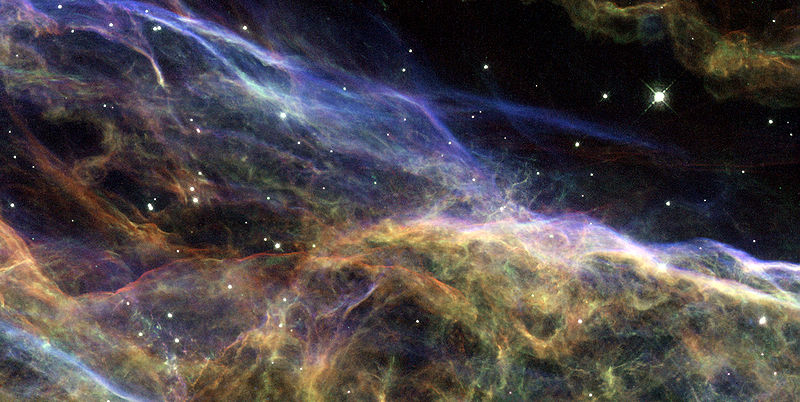
Portion of the Veil Nebula as photographed by the Hubble Space Telescope. This image is a composite of many separate exposures made by the WFPC2 instrument on the HST. Three filters were used to sample narrow wavelength ranges. The color results from assigning different hues (colors) to each monochromatic image. In this case, the assigned colors are: F502N ([O III]) blue; F656N (Halpha) green; F673N ([S II]) red: image created from HST data (exposure dates November 1994 / August 1997) in proposals 5774 and 5779 by J. Hester (Arizona State University) and J. Westphal (Caltech); image by NASA, ESA, and the Hubble Heritage (STScI/AURA)-ESA/Hubble Collaboration, 2 August 2007 (NASA)

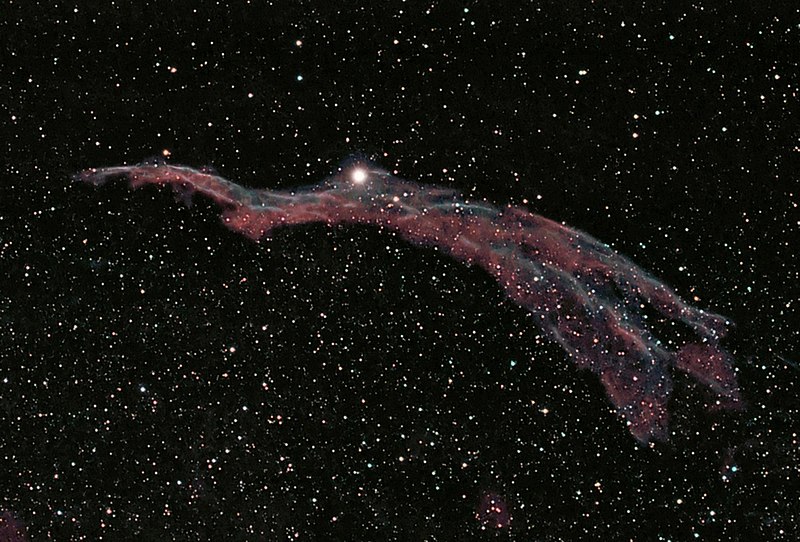
Western Veil of the Veil Nebula (aka Caldwell 34), consisting of NGC 6960 (the "Witch's Broom"), near the foreground star 52 Cygni: image by Hewlohooks (Hunter Wilson), 12 June 2007

Eastern Veil of the Veil Nebula (NGC6992/6995), bicolor Ha/OIII: image by Hewlohooks (Hunter Wilson), 26 August 2010

Eastern Veil of the Veil Nebula NGC 6992 (detail): image by Astrogallery (Antonio Ferretti / Albert Martinez Castillo), 25 August 2006
A Spectre in the Eastern Veil.
Menacing flying
forms and garish colors are a mark of the Halloween season.
They also stand out in this cosmic close-up
of the eastern Veil Nebula. The Veil Nebula itself is a
large supernova remnant, the expanding
debris cloud from the death explosion of a massive star.
While the Veil is roughly circular in shape covering nearly 3 degrees
on the sky in the constellation Cygnus, this portion of the eastern
Veil spans only 1/2 degree, about the apparent size of the Moon.
That translates to 12 light-years at the Veil's
estimated distance of 1,400 light-years from planet Earth.
In this composite of image data recorded through narrow band filters,
emission from hydrogen atoms in the remnant is shown in red with strong
emission from oxygen atoms in greenish hues.
In the western part of the Veil lies another seasonal apparition,
the Witch's Broom: image by Paul Mortfield, Stefano Cancelli, 1 November 2008 (NASA)
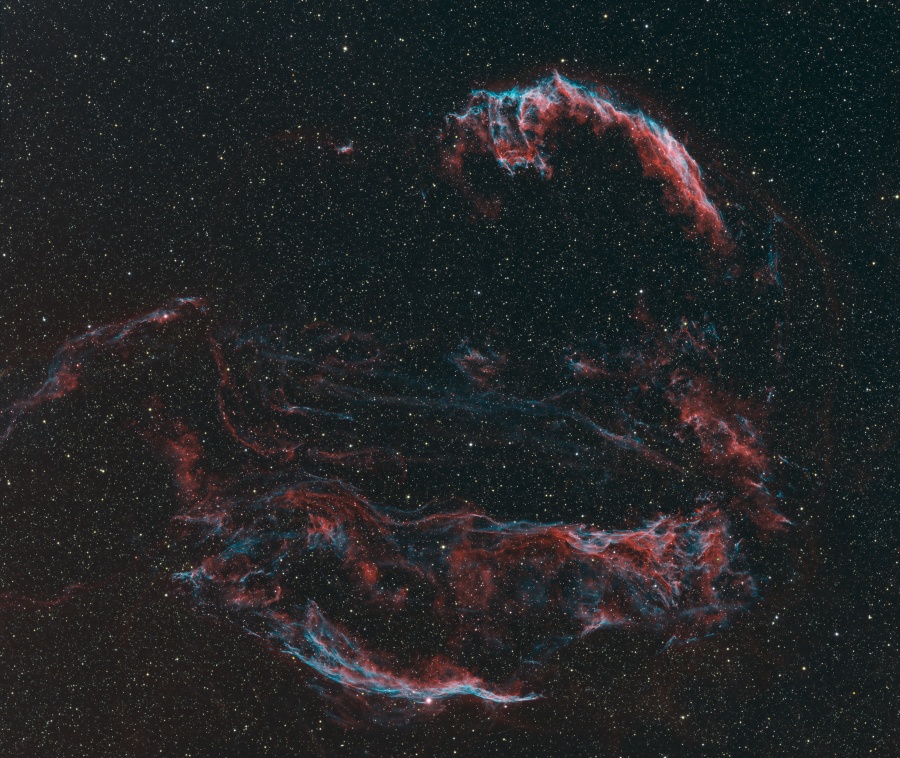
The Veil Nebula. Delicate in appearance, these filaments of shocked, glowing gas, draped in planet Earth's sky toward the constellation of Cygnus, make up the Veil Nebula. The nebula is a large supernova remnant, an expanding cloud born of the death explosion of a massive star. Light from the original supernova explosion likely reached Earth over 5,000 years ago. Also known as the Cygnus Loop, the Veil Nebula now spans nearly 3 degrees or about 6 times the diameter of the full Moon. That translates to over 70 light-years at its estimated distance of 1,500 light-years. In fact, the Veil is so large its brighter parts are recognized as separate nebulae, including The Witch's Broom (NGC 6960) at the bottom of this stunning skyview and Pickering's Triangle (NGC 6979) below and right of center. At the top is the haunting IC 1340: image and copyright by Martin Pugh, 16 September 2010 (NASA)
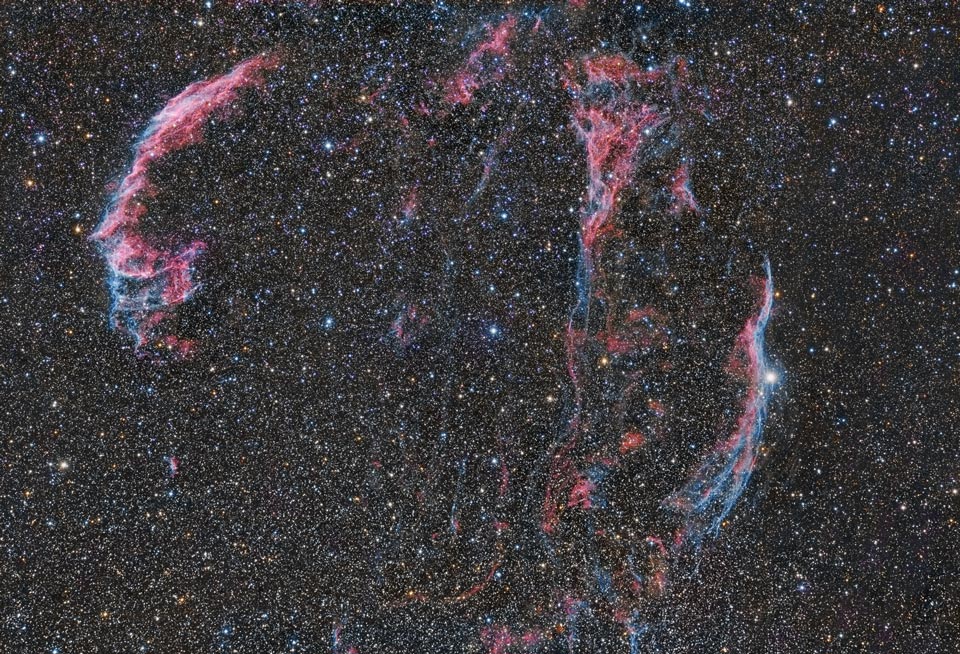




4 comments:
Now boarding...
You've given me a good laugh, TC, and I needed that. Here we all are, waiting in our own happy stomping ground.
Stars make such good endings.
In early spring 1967, a few months away from finishing a two-year stint as GI Joe at top-secret Sandia Base in Albuquerque, my girlfriend and I and another couple were in the back of a pickup parked quite a distance away from the super-tall, high-voltage electric fence encircling hush-hush Manzano Base, nonchalantly gazing at the heavens when we observed a star suddenly starting to get brighter and brighter until it seemed to explode, sending a ring around its center that kept growing larger and larger until it finally dissipated in the heavens—we couldn’t believe what we had just seen and I kept looking for days in the newspapers for any mention of it—nothing. To this day, I don’t know what it was we had seen—a supernova? Whatever it was, it gave us a real trip and we didn't have to board any rocketship.
Tom,
" an exposure time of 7400 seconds: " -- so perhaps we still have a few minutes more.
12.1
light coming into sky above still black
edge of ridge, blackness of pine branch
in foreground, sound of wave in channel
“physical,” “real and ideal,”
which in various ways
surface, relation of volume
to present, planes or
grey rain cloud against shadowed ridge,
silver of drops splashing into channel
Post a Comment